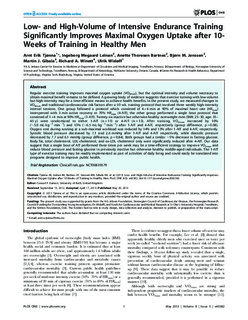| dc.contributor.author | Tjønna, Arnt Erik | |
| dc.contributor.author | Leinan, Ingeborg | |
| dc.contributor.author | Jenssen, Bjørn Munro | |
| dc.contributor.author | Gibala, Martin | |
| dc.contributor.author | Winett, Richard A. | |
| dc.contributor.author | Wisløff, Ulrik | |
| dc.contributor.author | Bartnes, Anette Thoresen | |
| dc.date.accessioned | 2015-11-16T14:01:00Z | |
| dc.date.accessioned | 2015-11-17T10:19:32Z | |
| dc.date.available | 2015-11-16T14:01:00Z | |
| dc.date.available | 2015-11-17T10:19:32Z | |
| dc.date.issued | 2013 | |
| dc.identifier.citation | PLoS ONE 2013, 8(5) | nb_NO |
| dc.identifier.issn | 1932-6203 | |
| dc.identifier.uri | http://hdl.handle.net/11250/2360515 | |
| dc.description.abstract | Regular exercise training improves maximal oxygen uptake (VO2max), but the optimal intensity and volume necessary to obtain maximal benefit remains to be defined. A growing body of evidence suggests that exercise training with low-volume but high-intensity may be a time-efficient means to achieve health benefits. In the present study, we measured changes in VO2max and traditional cardiovascular risk factors after a 10 wk. training protocol that involved three weekly high-intensity interval sessions. One group followed a protocol which consisted of 4×4 min at 90% of maximal heart rate (HRmax) interspersed with 3 min active recovery at 70% HRmax (4-AIT), the other group performed a single bout protocol that consisted of 1×4 min at 90% HRmax (1-AIT). Twenty-six inactive but otherwise healthy overweight men (BMI: 25–30, age: 35–45 y) were randomized to either 1-AIT (n = 11) or 4-AIT (n = 13). After training, VO2max increased by 10% (∼5.0 mL⋅kg−1⋅min−1) and 13% (∼6.5 mL⋅kg−1⋅min−1) after 1-AIT and 4-AIT, respectively (group difference, p = 0.08). Oxygen cost during running at a sub-maximal workload was reduced by 14% and 13% after 1-AIT and 4-AIT, respectively. Systolic blood pressure decreased by 7.1 and 2.6 mmHg after 1-AIT and 4-AIT respectively, while diastolic pressure decreased by 7.7 and 6.1 mmHg (group difference, p = 0.84). Both groups had a similar ∼5% decrease in fasting glucose. Body fat, total cholesterol, LDL-cholesterol, and ox-LDL cholesterol only were significantly reduced after 4-AIT. Our data suggest that a single bout of AIT performed three times per week may be a time-efficient strategy to improve VO2max and reduce blood pressure and fasting glucose in previously inactive but otherwise healthy middle-aged individuals. The 1-AIT type of exercise training may be readily implemented as part of activities of daily living and could easily be translated into programs designed to improve public health. | nb_NO |
| dc.language.iso | eng | nb_NO |
| dc.publisher | Public Library of Science | nb_NO |
| dc.title | Low- and High-Volume of Intensive Endurance Training Significantly Improves Maximal Oxygen Uptake after 10-Weeks of Training in Healthy Men | nb_NO |
| dc.type | Journal article | nb_NO |
| dc.type | Peer reviewed | en_GB |
| dc.date.updated | 2015-11-16T14:01:00Z | |
| dc.source.volume | 8 | nb_NO |
| dc.source.journal | PLoS ONE | nb_NO |
| dc.source.issue | 5 | nb_NO |
| dc.identifier.doi | 10.1371/journal.pone.0065382 | |
| dc.identifier.cristin | 1047078 | |
| dc.description.localcode | © 2013 Tjønna et al. This is an open-access article distributed under the terms of the Creative Commons Attribution License, which permits unrestricted use, distribution, and reproduction in any medium, provided the original author and source are credited. | nb_NO |
